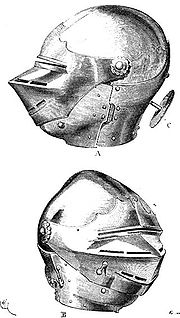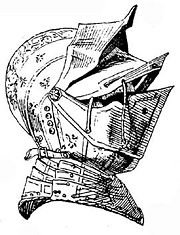
Armet
Encyclopedia


Hungarian language
Hungarian is a Uralic language, part of the Ugric group. With some 14 million speakers, it is one of the most widely spoken non-Indo-European languages in Europe....
: Csőrsisak "peaked helmet") is the name of a type of helmet
Helmet
A helmet is a form of protective gear worn on the head to protect it from injuries.Ceremonial or symbolic helmets without protective function are sometimes used. The oldest known use of helmets was by Assyrian soldiers in 900BC, who wore thick leather or bronze helmets to protect the head from...
developed in the 15th century, most likely in Italy
Italy
Italy , officially the Italian Republic languages]] under the European Charter for Regional or Minority Languages. In each of these, Italy's official name is as follows:;;;;;;;;), is a unitary parliamentary republic in South-Central Europe. To the north it borders France, Switzerland, Austria and...
, France
France
The French Republic , The French Republic , The French Republic , (commonly known as France , is a unitary semi-presidential republic in Western Europe with several overseas territories and islands located on other continents and in the Indian, Pacific, and Atlantic oceans. Metropolitan France...
, Spain
Spain
Spain , officially the Kingdom of Spain languages]] under the European Charter for Regional or Minority Languages. In each of these, Spain's official name is as follows:;;;;;;), is a country and member state of the European Union located in southwestern Europe on the Iberian Peninsula...
and Hungary
Hungary
Hungary , officially the Republic of Hungary , is a landlocked country in Central Europe. It is situated in the Carpathian Basin and is bordered by Slovakia to the north, Ukraine and Romania to the east, Serbia and Croatia to the south, Slovenia to the southwest and Austria to the west. The...
. It was distinguished by being the first helmet of its era to completely enclose the head while being compact and light enough to move with the wearer. The typical armet consisted of four pieces: the skull, the two hinged cheek pieces which lock at the front, and the visor. A multi-part reinforcement for the bottom half of the face, known as a wrapper, was sometimes added, and its straps attached to a metal disc at the base of the skull piece called a rondel
Rondel
Rondel may refer to:* Rondel or roundel, type of medieval dagger...
.
It reached its height of popularity during the 15th and 16th centuries when knights in medieval Europe wore plate armor into battle. Movable face and cheek pieces allowed the wearer to close the helmet, thus fully protecting the head from blows. Armets have often been confused with close helmets, and the two names can now be used almost interchangeably when referring to either form of helmet. Close helmets had a full visor and bevor (a chin/neck guard); the visor pivoted up and down by means of bolts attached to the side of the skull piece. Slightly different in design, armets had hinged cheek pieces which opened at the front of face backward. Note the similarities between the armet above and the close helmet to the lower left.
The armet is found in many contemporary pieces of artwork, such as Paolo Uccello
Paolo Uccello
Paolo Uccello , born Paolo di Dono, was an Italian painter and a mathematician who was notable for his pioneering work on visual perspective in art. Giorgio Vasari in his book Lives of the Artists wrote that Uccello was obsessed by his interest in perspective and would stay up all night in his...
's 'Battle of San Romano', and is almost always shown as part of a Milanese
Milan
Milan is the second-largest city in Italy and the capital city of the region of Lombardy and of the province of Milan. The city proper has a population of about 1.3 million, while its urban area, roughly coinciding with its administrative province and the bordering Province of Monza and Brianza ,...
armor.
The armet was most popular in Italy, and in Hungary as it was the first kingdom in Europe after Italy to inherit the Renaissance during the reign of Matthias Corvinus of Hungary
Matthias Corvinus of Hungary
Matthias Corvinus , also called the Just in folk tales, was King of Hungary and Croatia from 1458, at the age of 14 until his death...
. However, in England and Western Europe the sallet
Sallet
The sallet was a war helmet that replaced the bascinet in northern Europe and Hungary during the mid-15th century. Some sallets were close fitting except at the back of the head where they extended and formed a pointed tail. Some Italian ones followed the shape of the neck, and had an additional...
helmet was preferred. It is believed that the close helm
Close helm
In Medieval armor, the close helm was a military helmet worn by knights and other combatants in the late medieval and early renaissance era. It carried a visor that pivoted up and fully enclosed the head and neck area, unlike earlier helms such as the sallet and barbute, which sometimes may have...
resulted from a combination of various elements of each.

Ewart Oakeshott
Ewart Oakeshott was a British illustrator, collector, and amateur historian who wrote prodigiously on medieval arms and armour. He was a Fellow of the Society of Antiquaries, a Founder Member of the Arms and Armour Society, and the Founder of the Oakeshott Institute...
"European Weapons and Armour. From Renaissance to the Industrial Revolution" ISBN 0-85115-789-0, page 121 in edition of 2000 by The Boydell Press, Woolbridge) the close helm
Close helm
In Medieval armor, the close helm was a military helmet worn by knights and other combatants in the late medieval and early renaissance era. It carried a visor that pivoted up and fully enclosed the head and neck area, unlike earlier helms such as the sallet and barbute, which sometimes may have...
is a helm which is very similar to armet, but has different method of opening. While an armet has two cheekpiece
Cheekpiece
A cheekpiece, cheek-piece, or cheek piece may refer to*A raised area on a rifle stock#Styles and features of stocks to support the cheek*A part of a bit for horses, e.g. bit shank*A part of body armor such as the armet...
s, a close helm instead them has a kind of bevor
Bevor
A bevor is a piece of plate armour designed to protect the neck, much like a gorget. A bevor can be made of a single solid piece or multiple articulated lamés around the neck and chin. The bevor was typically worn in conjunction with a sallet, and later with a burgonet, in a form known as a...
which is attached in same way to pivots as its visor.
However other authors do not make such difference between close helm and armet. E.g. Wendelin Boeheim in his "Handbuch der Waffenkunde. Das Waffenwesen in seiner historischen Entwicklung vom Beginn des Mittelalters bis zum Ende des 18 Jahrhunders" (Leipzig 1890) do not separate close helms and armets. However he separates "Burgundian" Armet as kind of an armet (or a close helm) which has specific vertigous joint for being attached for a special gorget
Gorget
A gorget originally was a steel or leather collar designed to protect the throat. It was a feature of older types of armour and intended to protect against swords and other non-projectile weapons...
made from movable rings.

